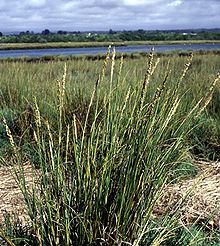Tribe Zoysieae Higher classification Grasses | Subfamily Chloridoideae Scientific name Spartina Rank Genus | |
 | ||
Lower classifications Spartina alterniflora, Spartina anglica, Spartina maritima | ||
How to identify salt marsh cordgrass spartina alterniflora
Spartina, commonly known as cordgrass or cord-grass, is a genus of plants in the grass family, frequently found in coastal salt marshes.
Contents
- How to identify salt marsh cordgrass spartina alterniflora
- Smooth cord grass salt marsh cord grass spartina alterniflora
- Cultivation
- Ecology
- As an invasive species
- References
The genus name is derived from σπαρτίνη (spartiné), the Greek word for a cord made from Spanish broom (Spartium junceum). They are native to the coasts of the Atlantic Ocean in western and southern Europe, northwest and southern Africa, the Americas and the southern Atlantic Ocean islands; one or two species also occur on the North American Pacific Ocean coast and in freshwater habitats inland in the Americas. The highest species diversity is on the east coasts of North and South America, particularly Florida.
They form large, often dense colonies, particularly on coastal salt marshes, and grow quickly. The species vary in size from 0.3–2 m tall. Many of the species will produce hybrids if they come into contact.
- Spartina alterniflora Loisel. – smooth cordgrass - Atlantic coasts of North + South America, West Indies
- Spartina anglica C.E.Hubb. – common cordgrass - Great Britain; introduced scattered other places
- Spartina arundinacea (Thouars) Carmich - Tristan da Cunha, Amsterdam Island in Indian Ocean
- Spartina bakeri Merr. – sand cordgrass - southeastern USA
- Spartina × caespitosa A.A.Eaton – short cordgrass - eastern USA + Canada (PEI to VA)
- Spartina ciliata Brongn. - Brazil, Argentina, Uruguay
- Spartina cynosuroides (L.) Roth – big cordgrass - eastern USA (TX to MA); Tamaulipas, Chihuahua, Bahamas
- Spartina densiflora Brongn. – denseflower cordgrass - Venezuela, Brazil, Argentina, Uruguay, Chile
- Spartina foliosa Trin. – California cordgrass - California, Baja California, Baja California Sur
- Spartina gracilis Trin. – alkali cordgrass - western Canada, western + central USA, Chihuahua, Jalisco, Michoacán
- Spartina longispica Hauman & Parodi ex St.-Yves - Argentina, Uruguay
- Spartina maritima (Curtis) Fernald – small cordgrass - Great Britain, Netherlands, Belgium, France, Spain, Portugal, Italy, Croatia, Morocco, Mauritania, Namibia, South Africa
- Spartina patens (Aiton) Muhl – saltmeadow cordgrass - east coast of North America from Labrador to Tamaulipas; West Indies
- Spartina pectinata Bosc ex Link – prairie cordgrass from Northwest Territories to Texas + Newfoundland
- Spartina spartinae (Trin.) Merr. ex Hitchc. – Gulf cordgrass - Atlantic coast of North America from Florida to Argentina, incl Caribbean + Gulf of Mexico
- Spartina × townsendii H.Groves & J.Groves (S. alterniflora × S. maritima) – Townsend's cordgrass - western Europe
- Spartina versicolor Fabre - Mediterranean, Azores
see Bouteloua Crypsis Dactylis Digitaria
Smooth cord grass salt marsh cord grass spartina alterniflora
Cultivation
Spartina has been planted by humans to reclaim estuarine areas for stripping, to supply fodder for livestock, and to prevent erosion. Various members of the genus (especially Spartina alterniflora and its derivatives, Spartina anglica and Spartina × townsendii) have spread outside of their native boundaries and become invasive.
Big cordgrass (S. cynosuroides) is used in the construction of bull's eye targets for sports archery. A properly constructed Spartina target can stop an arrow safely without damage to the arrowhead as it lodges in the target.
Ecology
Spartina species are used as food plants by the larvae of some Lepidoptera species including Aaron's skipper (which feeds exclusively on smooth cordgrass) and engrailed.
As an invasive species
Three of the Spartina species have become invasive plants in some countries. In British Columbia, Spartina anglica, also known as English cordgrass, is an aggressive, aquatic alien that invades mud flats, salt marshes and beaches, out-competing native plants, spreading quickly over mud flats and leaving large Spartina meadows.
